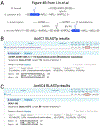Lack of Cas13a inhibition by anti-CRISPR proteins from Leptotrichia prophages
- PMID: 35623354
- PMCID: PMC9186262
- DOI: 10.1016/j.molcel.2022.05.002
Lack of Cas13a inhibition by anti-CRISPR proteins from Leptotrichia prophages
Abstract
CRISPR systems are prokaryotic adaptive immune systems that use RNA-guided Cas nucleases to recognize and destroy foreign genetic elements. To overcome CRISPR immunity, bacteriophages have evolved diverse families of anti-CRISPR proteins (Acrs). Recently, Lin et al. (2020) described the discovery and characterization of 7 Acr families (AcrVIA1-7) that inhibit type VI-A CRISPR systems. We detail several inconsistencies that question the results reported in the Lin et al. (2020) study. These include inaccurate bioinformatics analyses and bacterial strains that are impossible to construct. Published strains were provided by the authors, but MS2 bacteriophage plaque assays did not support the published results. We also independently tested the Acr sequences described in the original report, in E. coli and mammalian cells, but did not observe anti-Cas13a activity. Taken together, our data and analyses prompt us to question the claim that AcrVIA1-7 reported in Lin et al. are type VI anti-CRISPR proteins.
Keywords: Cas13a; RNA-targeting; Type VI CRISPR-Cas; anti-CRISPR; bacteriophage; bioinformatics; prophage; reproducibility.
Copyright © 2022 The Author(s). Published by Elsevier Inc. All rights reserved.
Conflict of interest statement
Declaration of interests J.B.-D. is a scientific advisory board member of SNIPR Biome and Excision Biotherapeutics and a scientific advisory board member and co-founder of Acrigen Biosciences. J.B.-D. is an inventor on patents filed by UCSF pertaining to Acr technology. B.P.K. is an inventor on patents and patent applications filed by Mass General Brigham that describe genome engineering technologies. B.P.K. consults for EcoR1 capital and ElevateBio and is an advisor to Acrigen Biosciences, Life Edit Therapeutics, and Prime Medicines.
Figures





References
Publication types
MeSH terms
Substances
Grants and funding
LinkOut - more resources
Full Text Sources
Research Materials

